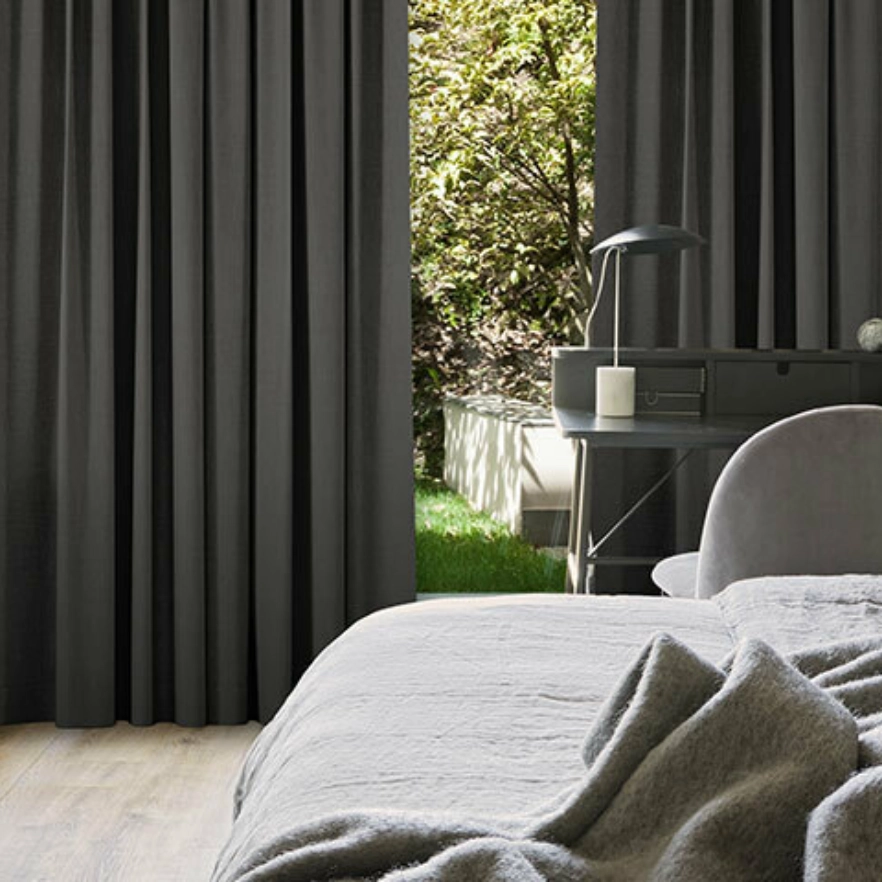Dark vs. light curtains – which should you choose?
Choosing the colour of your curtains is mainly determined by personal preference and there is no ‘wrong’ answer. However, there are definitely some things to consider to make sure you’re happy with the end result of how your curtains look and deciding to go light or dark can really change how a room feels. Let’s look at the pros and cons of each option.
Light Curtains
The benefits:
- They’re timeless choice! Light coloured curtains, especially whites and neutrals, will never go (far) out of style.
- Light curtains will make a space feel bigger.
- They are more likely to be made of lightweight curtain fabrics, which fall and flow beautifully.
- Lighter colours are easily dyed a different colour should you want an easy way to change it up in future.
- Light coloured curtains are good for rooms that get a lot of direct sunlight as they’re less prone to fading from the sun. Dark and bright colours tend to fade faster.
- Good summer options as a white/lighter colour is more likely to bounce the sun’s rays away keeping rooms cooler.
Things to consider:
- More likely to show dirt, dust or stains, so perhaps better in rooms without high traffic.
Dark Curtains
The benefits:
- Dark coloured curtains work very well in spacious interiors or high-ceilinged rooms to visually shrink the space and give it a cosier vibe.
- They’ll help anchor the space without overwhelming the setting; repeat the colour of the curtains somewhere else in the room so they don’t look out of place.
- They can help strike a balance between relaxing and romantic.
- Dark curtains lend a sense of drama, contrast and elegance to a room and can be very inviting.
- Dark curtains don’t show dirt and dust like light coloured curtains will so a good choice for high traffic areas (if the size is right).
- They’re simple to maintain and clean as stains and markings don't show all that much.
- A good choice for blocking light out of bedrooms for a better night’s sleep.
Things to consider:
- They’re often overwhelming in small rooms.
- Dark curtains are bit riskier. Because dark curtains can be very dominating in a room, if you don’t get the colour just right, it’s more likely to ruin the aesthetic than a lighter colour that isn’t quite right.
- Sunlight will fade dark curtains faster.
- If unlined, during summer, a darker curtain will absorb heat and radiate it.
Tips for dark curtains:
Dark-coloured curtains work best against light walls (eg. warm white, cream, grey, light tan and even smoky blue walls). Dark walls plus dark curtains is usually too much and feels oppressive.
‘Dark’ doesn’t always mean black, brown or grey; dark curtains can also come in hip, modern colours such as blue or even certain shades of red or purple.
Curtain Lining
Lining provides an important extra layer to the fabric, which can act to reflect or retain heat and also protect the colour from sunlight saturation. Well-lined curtains can block light from filtering through regardless of whether the curtain fabric is light or dark in colour and lined curtains also hang well and are easy to manoeuvre.
Unlined curtains, while perfect in summer as they provide some sun protection whilst being light and allowing air to flow, may not be the best year-round choice. They are, however, very easy to clean in your own washing machine.
Types of lining
- Blockout - blocks most sunlight from filtering through, also helps keep out cold
- Polycotton – economical option, good at maintaining temperature in both warm and cold temperatures
- Thermal – thick and designed to provide maximum heat retention (will also help keep a room cool in summer)
Still not sure whether to get light or dark curtains?
Order a few free samples and see how they look in your own home. Compare different colours against your walls and hold them up to the windows to get a sense for how much light they’ll block. Order your free samples now.

